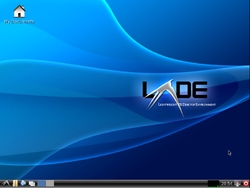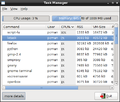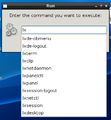LXDE
 | |
 Default LXDE desktop | |
| Developer(s) | The LXDE Team |
|---|---|
| Initial release | 2006 |
| Preview release | 0.5.0
/ December 10, 2009 |
| Repository | |
| Written in | C (GTK+) |
| Operating system | Unix-like |
| Available in | Multilingual |
| Type | Desktop environment |
| License | GNU GPL, GNU LGPL |
| Website | lxde.org |
LXDE is a free and open source desktop environment for Unix and other POSIX compliant platforms, such as Linux or BSD. The name LXDE stands for "Lightweight X11 Desktop Environment".[1][2]
LXDE is designed to work well with computers on the low end of the performance spectrum such as older resource-constrained machines, new generation netbooks, and other small computers. Testing has shown that LXDE has a small energy-efficiency advantage over GNOME, KDE, and Xfce,[3] and consumes considerably less memory under certain typical workloads.[4][5]
LXDE can be built on top of various Linux distributions such as Arch Linux, Debian, Mandriva, Ubuntu, and more recently, Fedora and openSUSE. It is the native desktop environment of Knoppix, Lubuntu and U-lite, amongst others.
History
The project was started in 2006 by Taiwanese programmer Hong Jen Yee, also known as PCMan, when he published PCManFM, a new file manager and the first module of LXDE.
LXDE is written in the C programming language, using the GTK+ toolkit, and runs on Unix and other POSIX compliant platforms, such as Linux and BSD. GTK+ is commonly used in many Linux distributions and allows applications to run on different platforms.[6] LXDE uses rolling releases for the individual components (or group of components with coupled dependencies).[7] LXDE includes GPL licensed code as well as LGPL licensed code.[1]
In reviewing Linux distribution rankings for DistroWatch in early January 2011 for the year 2010 versus 2009, Bodnar Ladislav noted the increase in popularity of LXDE versus other desktop environments. He said, "Looking through the tables, an interesting thing is the rise of distributions that use the lightweight, but full-featured LXDE desktop or the Openbox window manager. As an example, Lubuntu now comfortably beats Kubuntu in terms of page hits, while CrunchBang Linux, a lightweight distribution with Openbox is still in the top 25 even though it failed to produce a stable release for well over a year. Many other distributions started offering LXDE-based editions of their products, further contributing to the dramatic rise in popularity of this relatively new desktop environment."[8]
Components
Unlike in other major desktop environments such as GNOME and KDE, the components of LXDE have few dependencies and are not tightly integrated.[9] Instead, they can run independently of each other.[10]
LXDE consists of several components:
| PCMan File Manager | File manager |
| LXInput | Mouse and keyboard configuration tool |
| LXLauncher | Easy-mode application launcher |
| LXPanel | Desktop panel |
| LXSession | X session manager |
| LXAppearance | GTK+ theme switcher |
| Leafpad | Text editor |
| Xarchiver | File archiver |
| GPicView | Image viewer |
| LXMusic | An XMMS2 client, audio player |
| LXTerminal | Terminal emulator |
| LXTask | Task manager |
| LXRandR | A GUI front-end to RandR |
| LXDM | X display manager |
| LXNM | Lightweight network connection helper daemon. Supports wireless connections (Linux only). |
| Openbox | Window manager |
| obconf | A GUI tool to configure Openbox |
-
LXDE Picture Viewer
-
LXAppearance
-
LXPanel
-
LXPanel Preferences
-
LXTask
-
PCManFM
-
PCManFM
-
Autocompletion of Panel tasks
See also
References
- ^ a b LXDE Team (undated). "LXDE". Retrieved 2008-10-26.
{{cite web}}: Check date values in:|year=(help)CS1 maint: year (link) - ^ LXDE Team (undated). "About LXDE". Retrieved 2008-11-01.
{{cite web}}: Check date values in:|year=(help)CS1 maint: year (link) - ^ Power & Memory Usage Of GNOME, KDE, LXDE & Xfce
- ^ Larabel, Michael. "[Phoronix] Power & Memory Usage Of GNOME, KDE, LXDE & Xfce". Phoronix. Retrieved 7 May 2011.
- ^ Linux Magazine, Christopher Smart (2009-09-09). "Lubuntu: Floats Like a Butterfly, Stings Like a Bee". Retrieved 2009-09-10.
- ^ "GTK+ Features".
- ^ Description of current release process
- ^ Bodnar, Ladislav (2011). "DistroWatch Page Hit Ranking statistics in 2009 and 2010". DistroWatch. Retrieved 4 January 2011.
{{cite news}}: Unknown parameter|month=ignored (help) - ^ Łukasz Bigo. "LXDE - lekka alternatywa do GNOME". Retrieved 2008-08-08.
- ^ About LXDE








